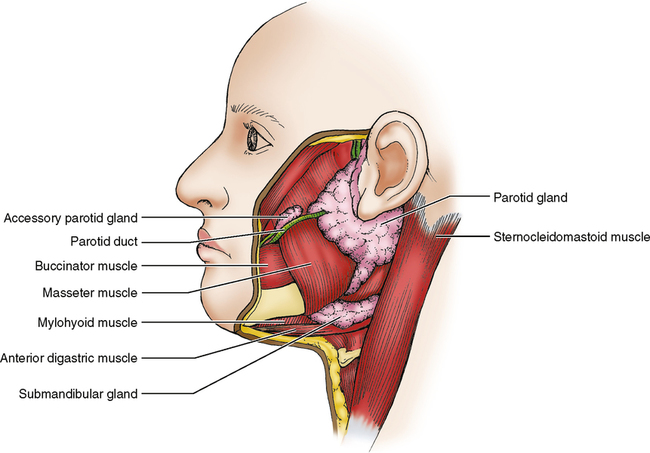Salivary Glands
As you may recall from Chapter 17, the glands of the body are classified in a number of ways. Salivary glands are classed as exocrine, merocrine, compound tubuloalveolar, serous, mixed, or mucous. They are also divided into major salivary glands, which are the three pairs of large glands, and minor salivary glands, which are found throughout the oral cavity.
MAJOR SALIVARY GLANDS
The major salivary glands are three pairs of glands that produce the bulk of the fluid in the mouth. This fluid is saliva, which mixes with food to make it easy to swallow and begins to break down starches into smaller carbohydrate units; further food breakdown takes place in the stomach. Saliva also keeps the mucosa in the oral cavity from drying out and aids in swallowing and speech (review Chapter 25 for the other functions of saliva). The three gland pairs are the parotid, the submandibular, and the sublingual.
Parotid Gland
The parotid gland is located on the surface of the masseter muscle, behind the ramus of the mandible and on the medial side of the ramus (see Chapter 26). It is composed of many grapelike clusters of cells, which secrete into a system of tubes leading to the oral cavity. If you look at the cells of the secretory part of the gland through a microscope, you will see that the cells are all the same type—they produce a thin, watery secretion referred to as serous secretion. Although these glands are the largest of the salivary glands, the pair of them produce only about 25% of the total resting salivary volume. Fig. 33-1 shows the location of the gland. You can see that the duct leading from the gland travels anteriorly across the masseter muscle (see Chapter 28) and pierces the buccinator muscle (see Chapter 30) to open into the oral cavity opposite the maxillary second molar. Mumps is a viral infection of the parotid gland and possibly other glands, which causes pain when the gland secretes. Thus for a person with mumps, eating is sometimes quite painful because it causes stimulation of the gland.
Submandibular (Submaxillary) Gland
The submandibular (submaxillary) gland provides about 60% to 65% of the total resting salivary volume. It is called a mixed gland because it includes both serous and mucous cells. Mucous secretion is thicker and stickier than serous secretion, and although almost two thirds of the cells in the submandibular gland are serous, the mucous component results in a slightly viscous secretion. The gland is located below and toward the posterior part of the body of the mandible (see Chapter 26). Place your finger on the inferior border of the mandible and run it back toward the angle of the mandible. As you near the angle, you will feel a slight depression in t/>
Stay updated, free dental videos. Join our Telegram channel

VIDEdental - Online dental courses



